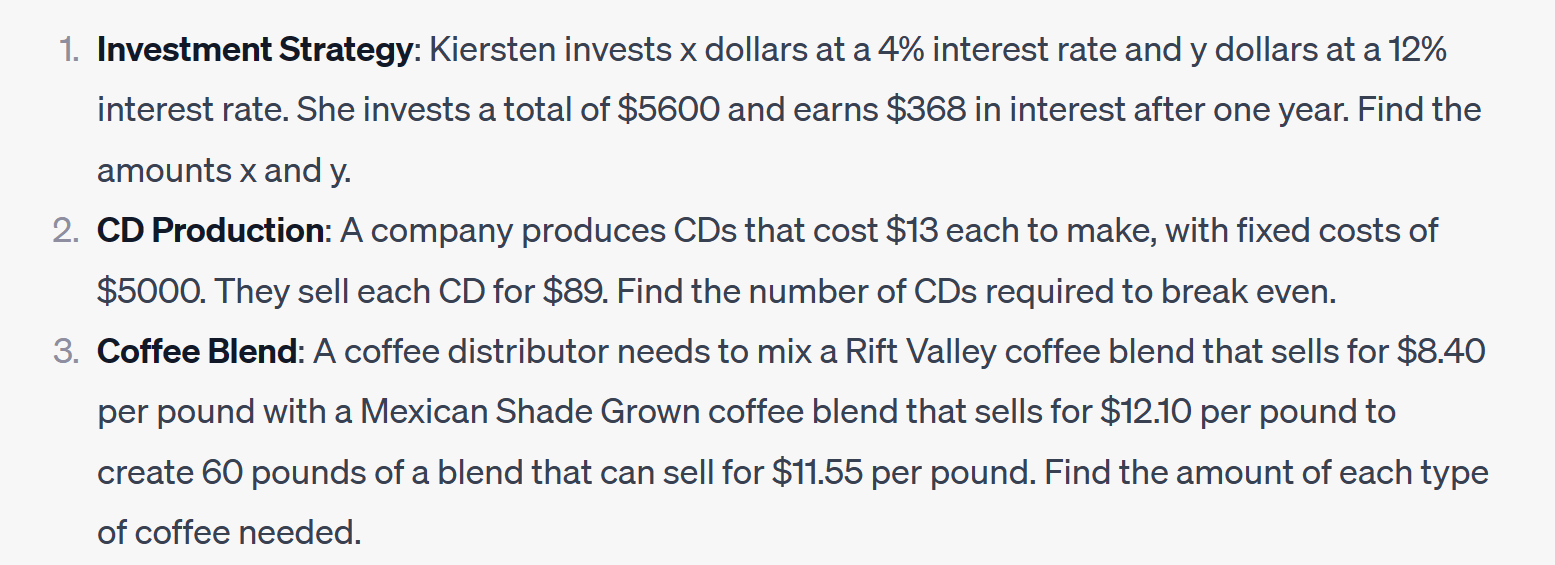Investment Strategy: How to Allocate Funds for Maximum Interest
Question Statement: Kiersten puts x dollars into an investment with an interest rate of 4% per year. She puts y dollars into another investment with an interest rate of 12% per year. She invests a total of $5600, and the interest earned after one year is $368. How should she allocate her funds?
Equation 1 (Total Investment): x + y = 5600
This equation signifies the total amount of money, $5600, that Kiersten has invested in both accounts.
Equation 2 (Total Interest Earned): 0.04x + 0.12y = 368
This equation represents the total interest of $368 earned from both investments after one year.
Solution:
To find the values of x and y, we can solve these equations simultaneously. Solving Equation 1 for x gives us x = 5600 – y. Plugging this into Equation 2, we get 0.04(5600 – y) + 0.12y = 368. Solving this equation yields y = 1800. Therefore, x = 5600 – 1800 = 3800.
Kiersten should invest $1800 at 12% and $3800 at 4% to maximize her interest earnings.
Business Economics: Calculating Break-Even Point for CD Production
Question Statement: A company produces CDs that cost $13 per CD to make, and the fixed costs are $5000. They will sell the CDs for $89 each. How many CDs does the company need to produce and sell to break even?
Equation 1 (Total Cost): C = 5000 + 13x
This equation represents the total cost of producing x number of CDs, including a fixed cost of $5000 and a variable cost of $13 per CD.
Equation 2 (Revenue): Revenue = 89x
This equation represents the total revenue from selling x number of CDs at $89 each.
Equation 3 (Profit): Profit = 89x – (5000 + 13x)
This equation represents the profit made from selling x number of CDs.
Solution:
To find the break-even point, we set the total cost equal to the revenue: 5000 + 13x = 89x. Solving this equation gives us x = 66 (rounded to the nearest whole number).
The company needs to produce and sell 66 CDs to break even.
Coffee Blend Math: Mixing Two Types of Coffee for a Specific Price
Question Statement: A coffee distributor needs to mix a Rift Valley coffee blend that normally sells for $8.40 per pound with a Mexican Shade Grown coffee blend that normally sells for $12.10 per pound to create 60 pounds of a coffee that can sell for $11.55 per pound. How many pounds of each kind of coffee should they mix?
Equation 1 (Total Weight): r + m = 60
This equation represents the total weight of the coffee blend, consisting of r pounds of Rift Valley blend and m pounds of Mexican Shade Grown blend.
Equation 2 (Total Income): 8.40r + 12.10m = 693
This equation represents the total income from the coffee blend, calculated based on the price per pound of each type of coffee.
Solution:
We first solve Equation 1 for r: r = 60 – m
Then we substitute this into Equation 2: 8.40(60 – m) + 12.10m = 693
Solving this equation gives us m = 51.08 and r = 8.92 (rounded to two decimal places).
The distributor should mix 51.08 pounds of Mexican Shade Grown coffee and 8.92 pounds of Rift Valley coffee to create the desired blend.

